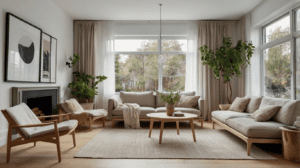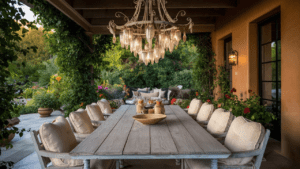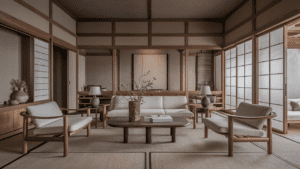Garden rooms blur the lines between indoors and outdoors, offering a unique retreat that can be enjoyed throughout the year.
In this comprehensive guide, I’ll walk you through the process of designing a garden room that’s not just a fair-weather friend, but a year-round sanctuary.
Introduction: Embracing the Garden Room Concept
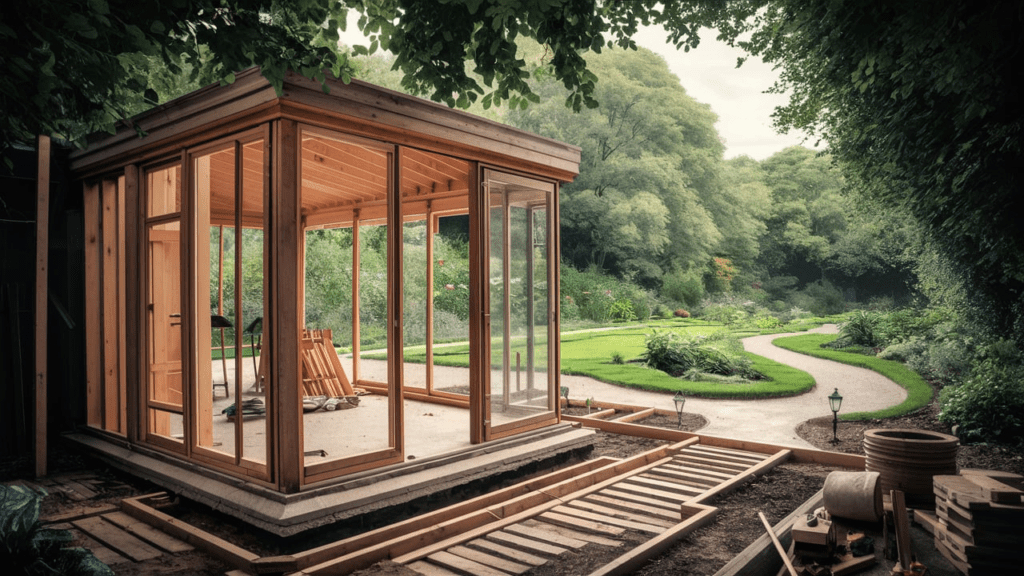
When I first started designing garden rooms, I was amazed at how these spaces could transform both homes and lives.
A garden room is more than just a glorified shed or a greenhouse; it’s a fully functional living space that connects you with nature while providing the comforts of home.
The benefits of a year-round garden room are numerous:
- Extended living space without the cost of a full home addition
- A dedicated area for hobbies, work, or relaxation
- Increased property value
- A stronger connection to your garden and outdoor environment
I’ll never forget the joy on my client Sarah’s face when she first stepped into her completed garden room. “It’s like I’ve gained a whole new wing of my house,” she exclaimed, “but with a view, I could never get indoors!”
Planning Your Garden Room: Laying the Groundwork for Success
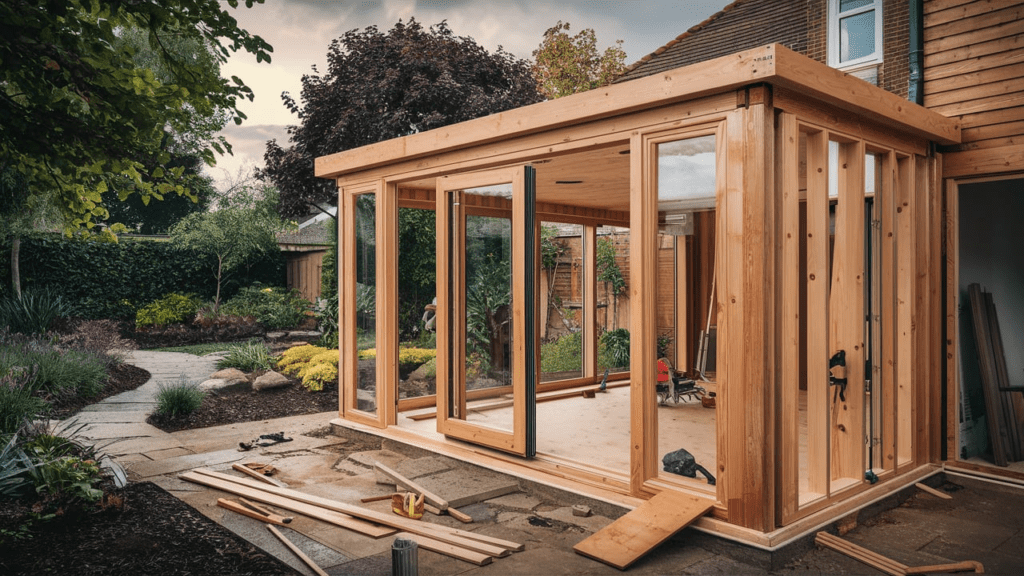

1. Choosing the Right Location
The first step in creating your perfect garden room is selecting the ideal location. Consider factors such as:
- Sun exposure throughout the day and seasons
- Proximity to your main house
- Views from the garden room
- Privacy from neighbors
I always advise my clients to spend time in their garden at different times of the day before deciding on a location. One client, Tom, was set on a spot until we realized it would be in complete shade by 3 pm in winter – not ideal for a year-round space!
2. Determining the Size and Shape
The size and shape of your garden room will depend on:
- Available space in your garden
- Intended use of the room
- Budget constraints
- Local building regulations
Pro tip: Don’t forget to factor in space for paths and landscaping around the garden room. A well-designed approach can enhance the overall look and feel of the space.
3. Legal Considerations and Permits
Before you get too far into the design process, it’s crucial to understand local regulations. Some areas to research include:
- Planning permission requirements
- Building codes and regulations
- Restrictions on the size or height of structures
- Proximity to property lines
Do I need planning permission for a garden room?
In many cases, garden rooms fall under “permitted development” and don’t require planning permission. However, this can vary depending on your location, the size of the structure, and its intended use. Always check with your local planning authority before proceeding with construction.
Structural Elements of a Garden Room: Building a Solid Foundation
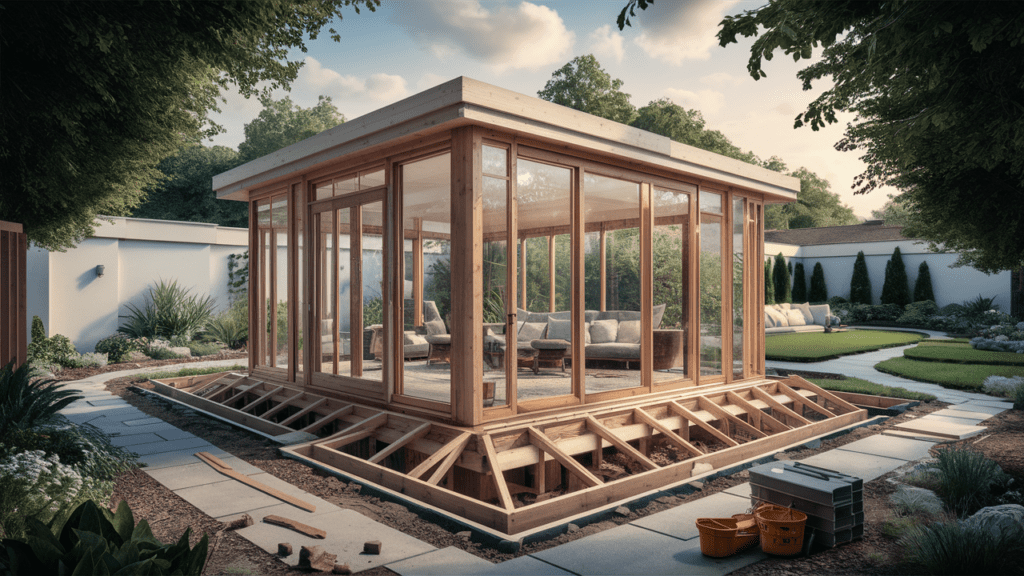

1. Foundation Options
The foundation of your garden room is crucial for its longevity and stability. Options include:
- Concrete slab: Ideal for larger structures or those with heavy equipment
- Strip foundations: Good for smaller buildings on level ground
- Pile foundations: Suitable for sloping or uneven terrain
I once worked on a garden room project where the client insisted on skimping on the foundation to save costs. Six months later, we were dealing with a tilting structure and cracked walls. Trust me, a solid foundation is worth every penny!
2. Walls and Insulation
For year-round use, proper insulation is non-negotiable. Consider:
- SIPs (Structural Insulated Panels) for excellent thermal performance
- Traditional timber frame with high-quality insulation
- Breathable materials to prevent moisture build-up
3. Roofing Choices for All Seasons
Your roof needs to withstand everything from summer heat to winter snow. Options include:
- Green roofs for added insulation and eco-friendliness
- EPDM rubber roofing for durability and weather resistance
- Traditional tiles for a more integrated look with your main house
- Glazing and Natural Light: Bringing the Outdoors In
4. Types of Windows and Doors
The right glazing can make or break a garden room. Consider:
- Bi-fold doors for seamless indoor-outdoor flow
- Floor-to-ceiling windows for unobstructed views
- Double or triple glazing for insulation
5. Skylights and Roof Lanterns
Nothing beats natural light from above. Options include:
- Fixed skylights for constant light
- Opening skylights for ventilation
- Roof lanterns for a dramatic architectural feature
6. Managing Sunlight and Heat Gain
While natural light is desirable, too much can lead to overheating. Solutions include:
- Exterior blinds or shutters
- Solar control glass
- Strategically placed overhangs or pergolas
How much glazing should a garden room have?
The ideal amount of glazing depends on the room’s orientation and intended use. As a rule of thumb, aim for glazing on at least one full wall to maximize natural light and views. However, be cautious about too much south-facing glass, which can lead to overheating in summer.
Garden Room Climate Control: Comfort in Every Season
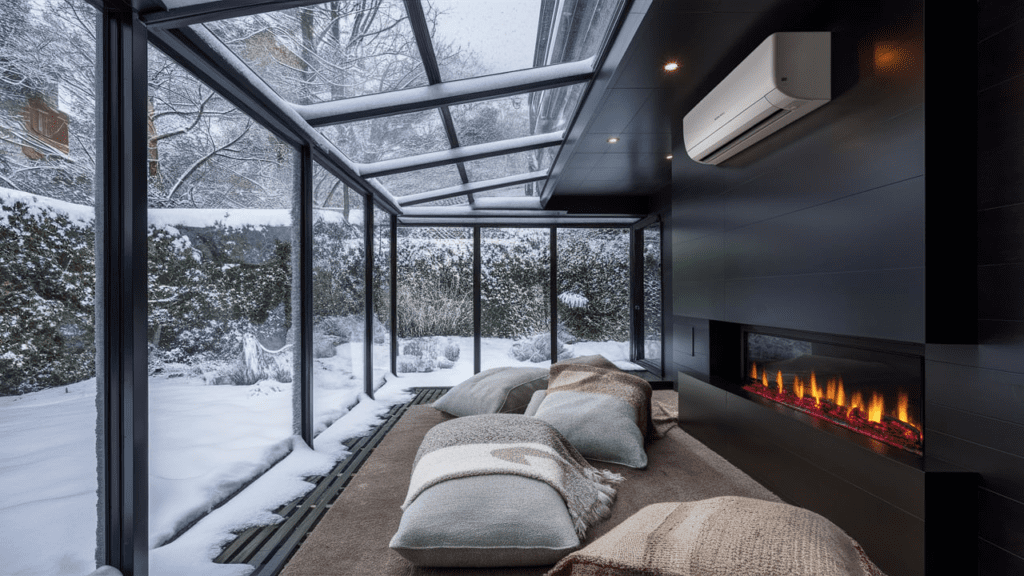

1. Heating Options for Winter Use:
Keep your garden room cozy when temperatures drop with:
- Underfloor heating for efficient, even warmth
- Wall-mounted radiators for traditional heating
- Wood-burning stoves for a rustic touch (check local regulations)
2. Cooling Solutions for Summer Comfort
Prevent your garden room from becoming a greenhouse in summer:
- Ceiling fans for air circulation
- Portable air conditioning units
- Passive cooling techniques like cross-ventilation
3. Ventilation Systems for Year-Round Air Quality
Good air quality is essential for a comfortable space:
- Mechanical ventilation with heat recovery (MVHR) systems
- Opening windows and doors for natural ventilation
- Trickle vents for constant background airflow
I once designed a garden room for a client in a particularly hot climate. We incorporated a combination of exterior shading, high-performance glazing, and a small, energy-efficient air conditioning unit. The result? A cool oasis even on the hottest summer days.
Electrical and Plumbing Considerations for a Garden Room
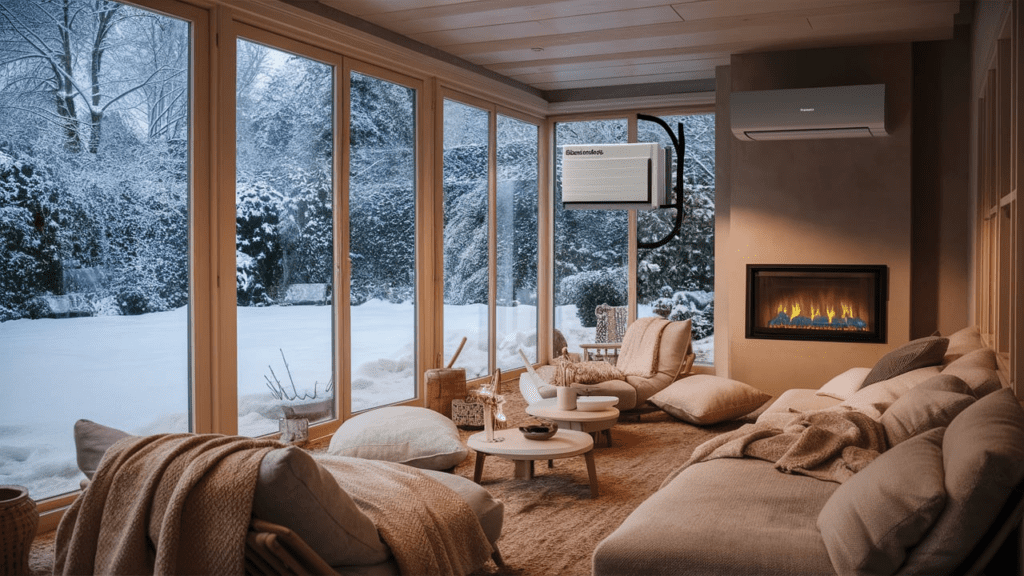

1. Power Supply and Lighting
A well-lit and powered garden room is essential for year-round use:
- Professional electrical installation with plenty of outlets
- A mix of task, ambient, and accent lighting
- Outdoor-rated fixtures for exterior lighting
2. Internet and Communication Setup
Stay connected in your garden retreat:
- Wired internet connection for reliability
- Wi-Fi extenders or mesh systems for wireless coverage
- Landline phone installation if needed
3. Water Access for Gardening or Kitchenettes
Consider adding water access for convenience:
- Outdoor tap for watering plants
- Small sink for a kitchenette or bar area
- Proper drainage to prevent water accumulation
Interior Design for Versatility: Creating a Flexible Garden Room
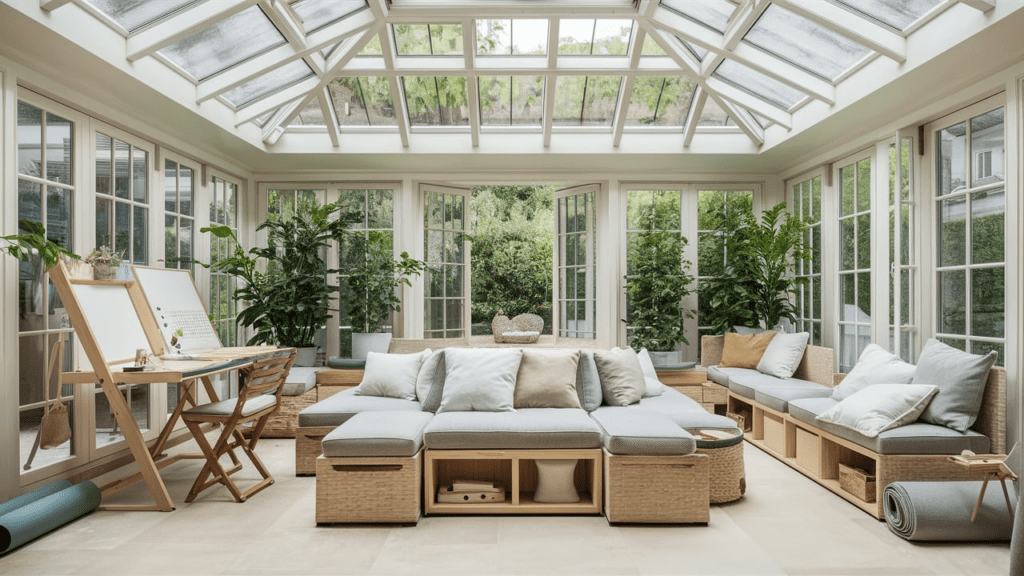

1. Multi-functional Furniture Ideas
Maximize your space with furniture that adapts:
- Fold-down desks or tables
- Modular seating that can be rearranged
- Ottoman storage for hidden organization
2. Storage Solutions for Seasonal Items
Keep your garden room tidy year-round:
- Built-in cabinets or shelving
- Underfloor storage for rarely used items
- Outdoor storage for gardening tools
3. Color Schemes and Textures for Year-Round Appeal
Choose a palette that works in all seasons:
- Neutral base colors with seasonal accent pieces
- Natural textures like wood and stone for timeless appeal
- Cozy textiles that can be swapped out seasonally
How can I make my garden room feel cozy in winter?
To create a cozy winter retreat, focus on warm lighting, plush textures, and rich colors. Add throw blankets, cushions, and perhaps a small area rug. Consider installing a small electric fireplace or wood-burning stove (if regulations allow) for both warmth and ambiance.
Connecting a Garden Room with Nature
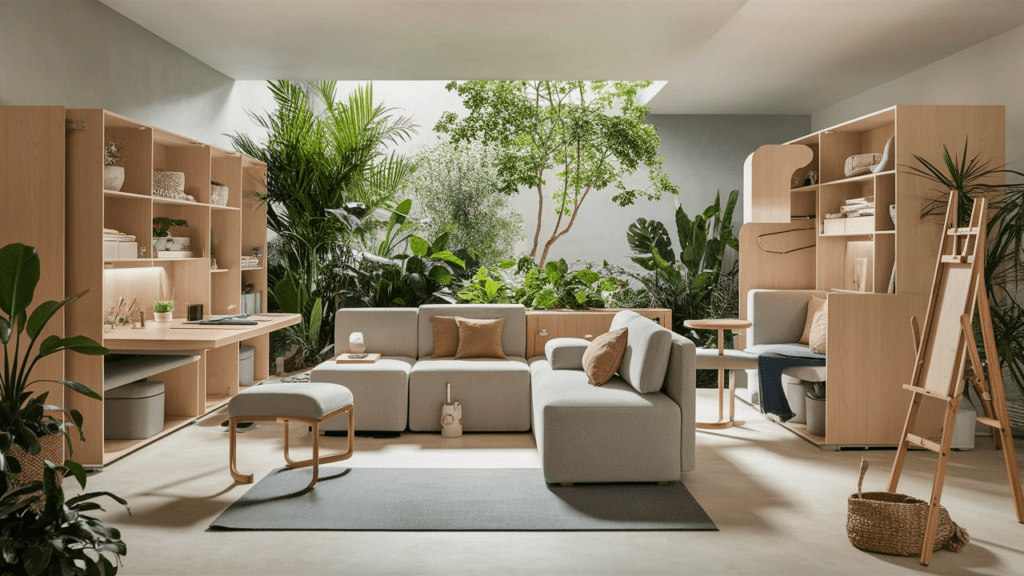

1. Indoor Plants for Garden Rooms
Bring the garden inside with:
- Large statement plants like fiddle leaf figs or bird of paradise
- Hanging plants to save floor space
- Easy-care succulents for low-maintenance greenery
2. Creating Seamless Indoor-Outdoor Transitions
Blur the boundaries between your garden room and the outdoors:
- Use similar flooring materials inside and out
- Install large sliding or bi-fold doors
- Extend your interior color scheme to outdoor furniture
3. Wildlife-Friendly Design Elements
Encourage local fauna to visit:
- Install bird feeders or baths visible from inside
- Plant native species around your garden room
- Consider a small water feature for ambiance and wildlife
Seasonal Decor and Adaptations for a Garden Room
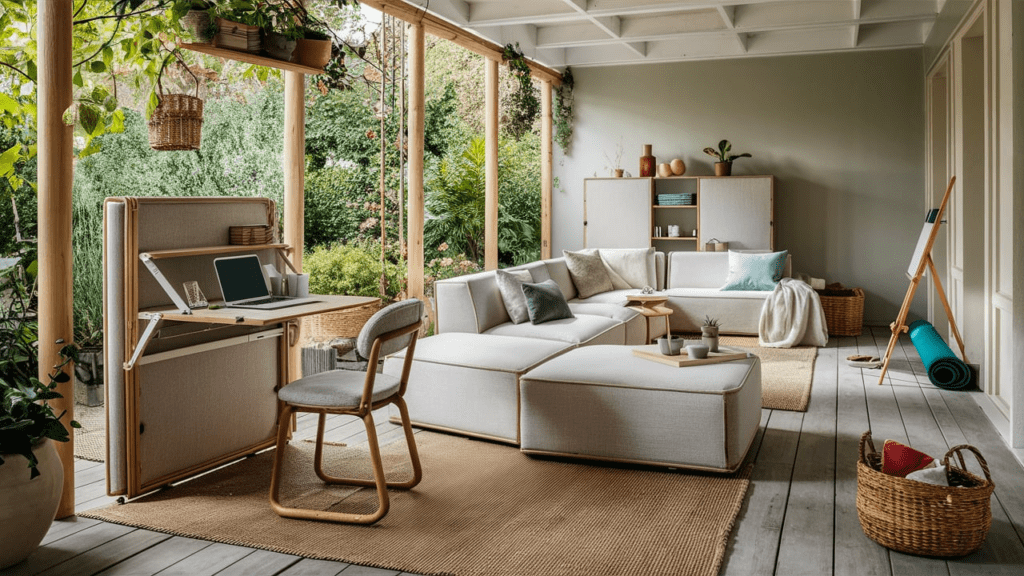

1. Spring and Summer Styling Tips
Embrace the warmer months with:
- Light, breezy curtains or blinds
- Fresh floral arrangements or potted herbs
- Bright, vibrant accent colors
2. Autumn and Winter Coziness Ideas
Create a warm retreat when temperatures drop:
- Add throw blankets and plush pillows
- Use warm lighting, including candles or string lights
- Incorporate rich, deep colors in your decor
3. Easy-to-Change Decor Elements
Keep your space fresh throughout the year:
- Use slipcovers to change the look of furniture seasonally
- Swap out artwork or prints to reflect the changing seasons
- Change scents with diffusers or candles to match the time of year
Eco-Friendly and Sustainable Garden Room Design: Nurturing Nature
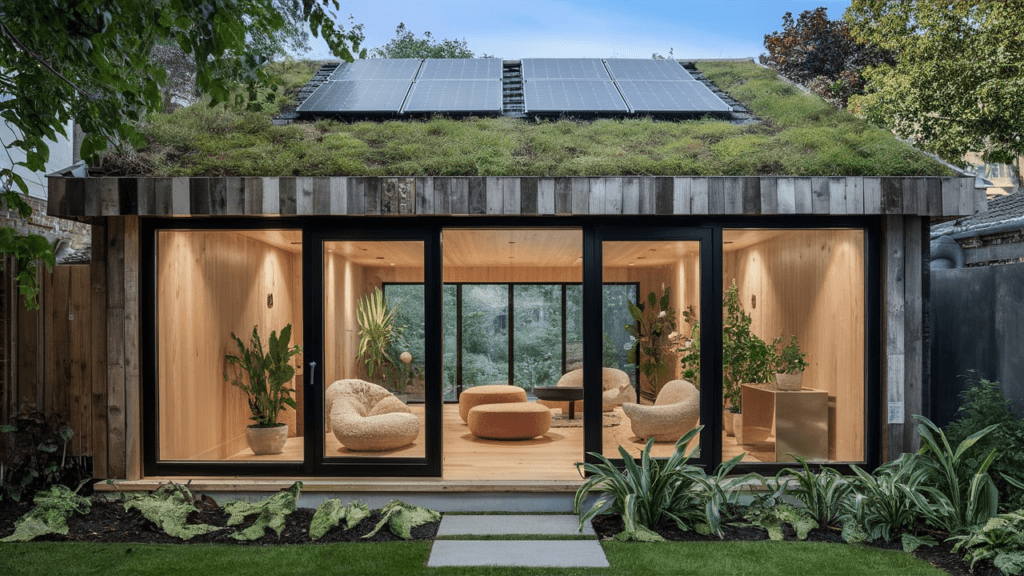

1. Green Building Materials
Minimize your environmental impact with:
- Reclaimed or sustainably sourced wood
- Low-VOC paints and finishes
- Recycled or upcycled materials where possible
How can I make my garden room more environmentally friendly?
Focus on using sustainable materials, maximizing natural light and ventilation, and incorporating energy-efficient systems. Consider adding solar panels if your location allows, and use smart home technology to optimize energy use. Don’t forget about the surrounding landscape – native plants require less water and maintenance.
2. Energy-Efficient Appliances and Fixtures
Reduce energy consumption with:
- LED lighting throughout
- Energy-star rated appliances if including a kitchenette
- Smart power strips to reduce standby power use
3. Rainwater Harvesting and Greywater Systems
Conserve water with:
- Rainwater collection for plant watering
- Greywater systems for irrigation (check local regulations)
- Drought-resistant landscaping around the garden room
Technology Integration: Smart Solutions for Modern Living
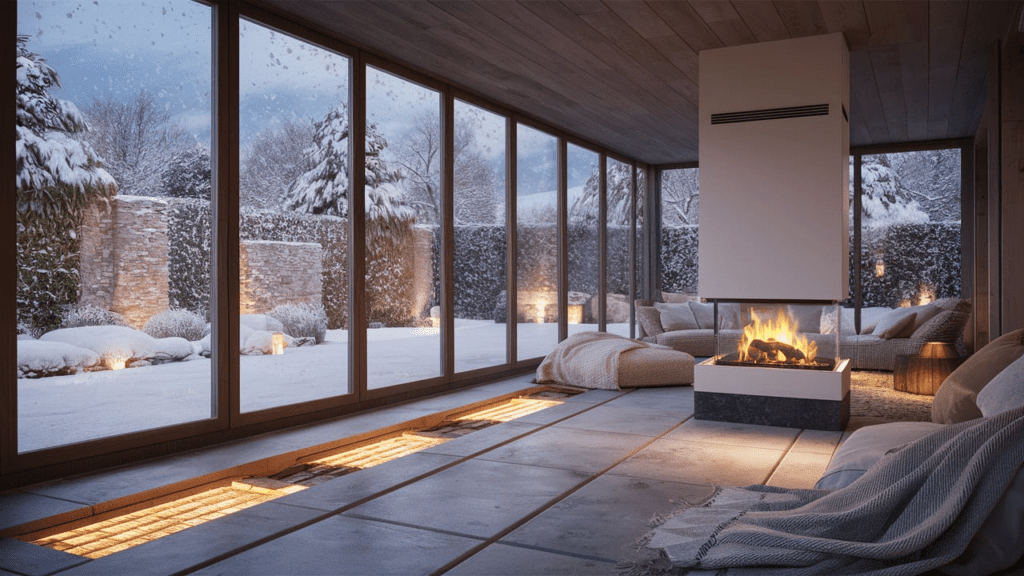

1. Smart Home Systems for Climate Control
Optimize comfort and efficiency with:
- Smart thermostats for programmable heating and cooling
- Automated blinds or shades for temperature management
- Occupancy sensors for lighting and climate control
2. Audio-Visual Setups for Entertainment
Create a multi-functional space with:
- Hidden speakers for immersive sound
- Projector and retractable screen for movie nights
- Smart TV for streaming and video calls
3. Work-from-Home Technology Considerations
Set up a productive workspace with:
- High-speed internet connection
- Ergonomic desk and chair setup
- Good lighting for video calls
Maintenance and Longevity of a Garden Room: Protecting Your Investment
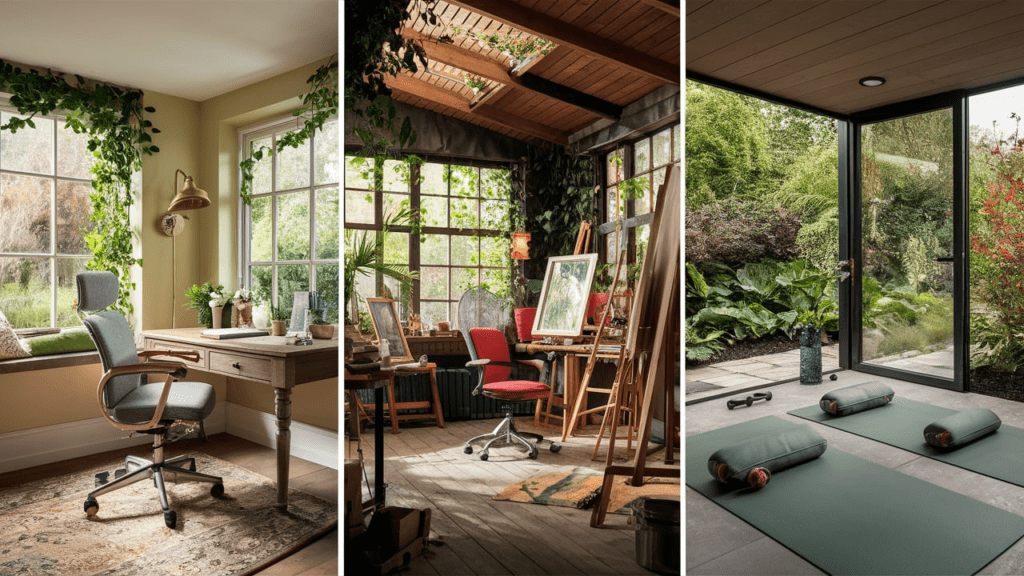

1. Weatherproofing Techniques
Ensure your garden room stands the test of time:
- Use weather-resistant exterior finishes
- Install proper guttering and drainage
- Apply UV-protective coatings to prevent fading
2. Seasonal Maintenance Checklist
Keep your garden room in top shape year-round:
- Clean gutters and check for leaks before winter
- Inspect and maintain heating and cooling systems seasonally
- Touch up exterior paint or stain as needed
3. Long-term Care for Different Materials
Preserve the beauty of your materials:
- Oil wooden decking or cladding annually
- Clean and reseal stone or concrete surfaces as recommended
- Regularly clean and maintain windows and doors
Budgeting and Cost Considerations of a Garden Room
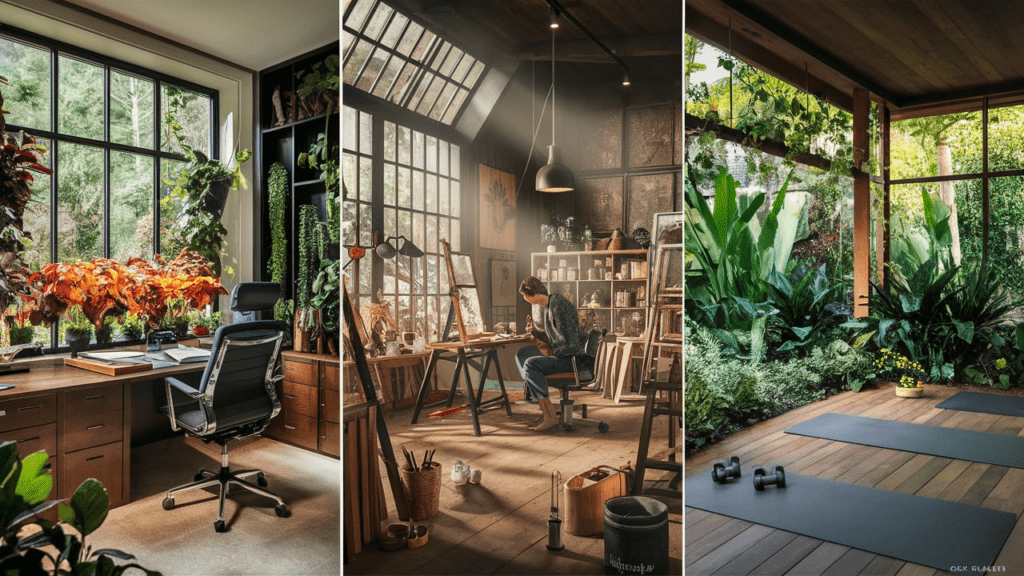

1. Estimating Initial Construction Costs
Plan your budget carefully, considering:
- Size and complexity of the structure
- Quality of materials used
- Any specialist features or technology
2. Ongoing Expenses
Factor in long-term costs such as:
- Heating and cooling expenses
- Regular maintenance and repairs
- Potential increases in home insurance premiums
3. Value-Adding Features for Resale
Invest in elements that boost property value:
- High-quality, durable materials
- Versatile design that appeals to various uses
- Energy-efficient features
Specialized Garden Room Ideas: Tailoring to Your Needs
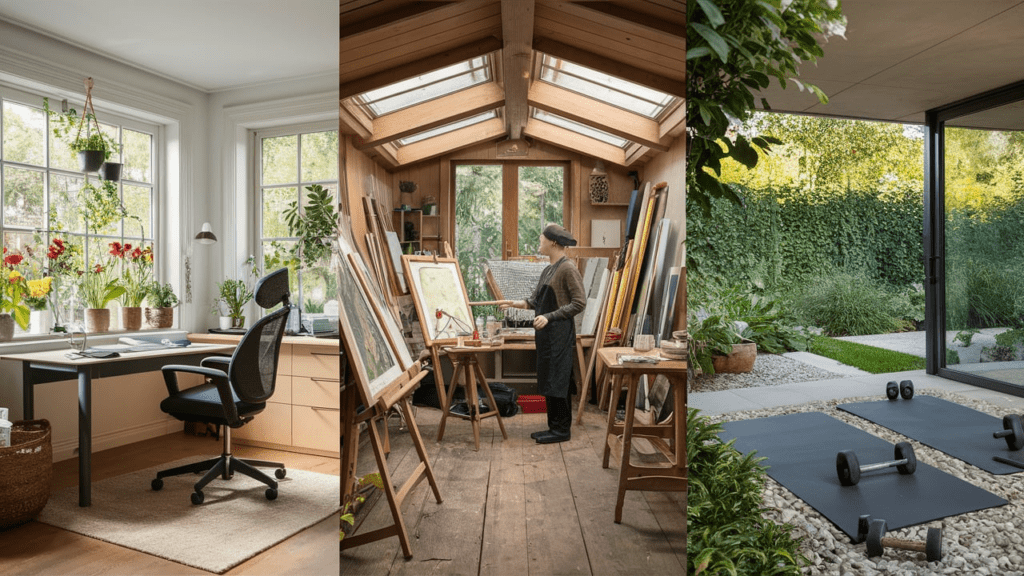

1. Home Office Garden Rooms
Create the perfect work-from-home space:
- Plenty of natural light to boost productivity
- Built-in desk and storage solutions
- Soundproofing for peace and quiet
2. Artistic Studios and Workshops
Design a space that fuels creativity:
- North-facing windows for consistent, neutral light
- Durable, easy-to-clean flooring
- Ample storage for supplies and equipment
3. Wellness and Fitness Spaces
Transform your garden room into a personal gym or yoga studio:
- Mirrors to check form during workouts
- Rubber flooring for comfort and safety
- Good ventilation for intense exercise sessions
Overcoming Common Challenges While Designing a Garden Room
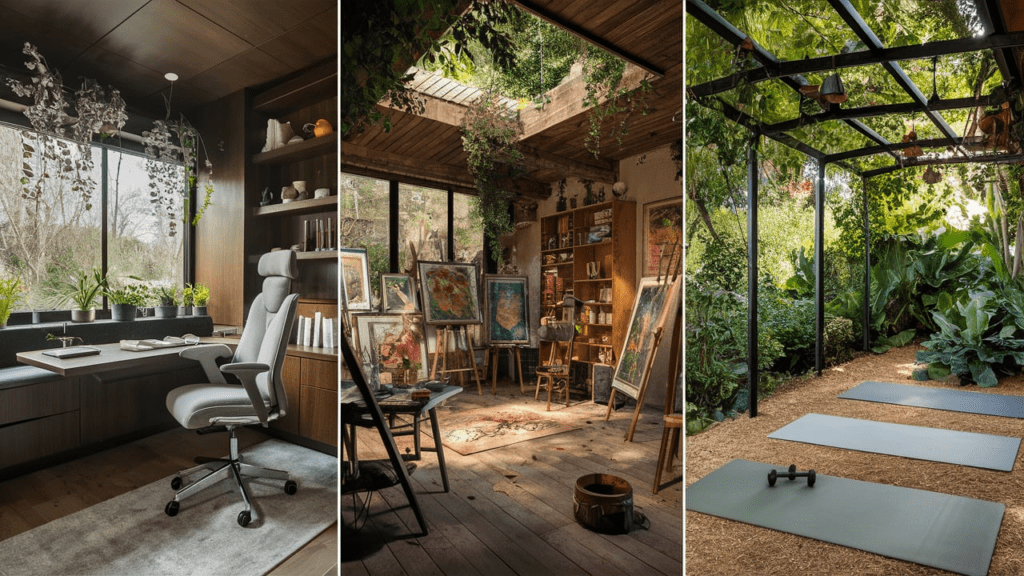

1. Dealing with Limited Space
Maximize a small footprint with:
- Multi-functional furniture
- Clever storage solutions
- Use of vertical space with shelving or loft areas
2. Managing Moisture and Humidity
Prevent damp issues with:
- Proper ventilation systems
- Dehumidifiers for problematic areas
- Moisture-resistant materials in high-risk zones
3. Noise Reduction Techniques
Create a peaceful retreat with:
- Double or triple-glazing
- Acoustic insulation in walls and ceiling
- Soft furnishings to absorb sound
How can I soundproof my garden room?
While complete soundproofing is challenging, you can significantly reduce noise by using dense insulation in walls and ceilings, installing double or triple-glazed windows, and using heavy curtains or blinds. Consider adding a layer of acoustic plasterboard to walls and ceilings, and use soft furnishings like rugs and upholstered furniture to absorb sound within the room.
Conclusion
Designing a garden room for year-round use is an exciting journey that allows you to create a truly personalized space that connects you with nature while providing all the comforts of home. From the initial planning stages to the final decorative touches, each decision you make will shape how you experience and enjoy your garden room throughout the changing seasons.
Remember, the key to a successful garden room is thoughtful planning and attention to detail. Consider how you’ll use the space throughout the year, and don’t be afraid to dream big – your garden room should be a reflection of your personality and lifestyle.
As you embark on your garden room project, keep in mind that flexibility is crucial. Your needs may change over time, so design a space that can adapt and grow with you. Whether you’re creating a peaceful home office, a vibrant entertainment space, or a serene yoga studio, your garden room has the potential to become your favorite part of your home.
I hope this guide has inspired you to start planning your own year-round garden room. Remember, every garden room is unique, just like every gardener. Embrace the process, have fun with the design, and soon you’ll have a beautiful, functional space that you can enjoy in every season. Happy designing!

